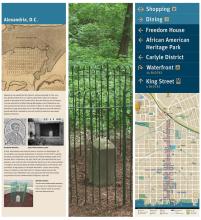Wayfinding: Alexandria, DC
Alexandria, D.C.

Alexandria was established by Virginia’s colonial assembly in 1749, over four decades before the U.S. Congress authorized creation of a national capital on the banks of the Potomac River. Once the final site for the Federal city was selected by President George Washington, part of Alexandria was incorporated into the District of Columbia in 1801. To mark the new capital’s boundaries, large stones were set in a ten-mile square at one mile intervals by Andrew Ellicott, assisted by men such as African American astronomer Benjamin Banneker.
At first, Alexandrians welcomed the town’s inclusion into Washington, D.C., but residents soon became disillusioned. Provisions of the 1791 Act creating the District precluded the construction of any Federal buildings south of the Potomac River. Furthermore, the 1801 District Act disenfranchised the local populace, who could not vote in presidential elections nor have representation in Congress. Discussions about possibly outlawing slavery in the District also provided a strong impetus to retrocede Alexandria, a major slave trading center, to Virginia. In July 1846, the U.S. Congress voted to permit the retrocession upon referendum and, once approved, the land was formally accepted back by the Commonwealth of Virginia a year later.
Alexandria, D.C. Boundary Stones
The first and southernmost boundary stone was set at Alexandria’s Jones Point, and four more such stones still exist within the city.
Where to Find This Sign
In Old Town, mini kiosks are located at designated intersections along King Street, Cameron Street, and the Waterfront to provide an orientation for pedestrians.
This wayfinding sign is located on the north side of King at Payne Street. (For those taking the King Street Trolley, please check the schedule as times may have changed.)
See all the wayfinding signs on and around King Street.